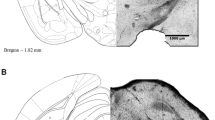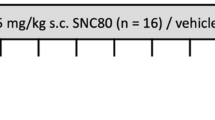Abstract
Rationale
Recent studies have shown that endogenous opioid systems are associated with the regulation of emotional responses. In particular, it has been reported that δ-opioid receptors act naturally to inhibit stress and anxiety.
Objective
The present study was designed to examine the possible involvement of opioid δ-receptor subtypes in the anxiety-related behavior in the elevated-plus-maze test.
Methods
Six-week-old male Lewis rats were used. The total numbers of visits to the closed and open arms and the cumulative time spent and visits in the open arms were determined. Plasma corticosterone levels were measured by enzyme immunoassay.
Results
Naltrindole (NTI), a δ-opioid receptor antagonist (3 mg/kg s.c.), induced a significant decrease in the percentages of time spent and visits in the open arms. Naltriben (NTB), a δ2-opioid receptor antagonist (3 mg/kg s.c.), but not 7-benzylidenenaltrexone, a δ1-opioid receptor antagonist, produced similar anxiety-related behaviors in the elevated plus-maze. These effects of NTI and NTB were antagonized by pretreatment with (+)-4-[(aR)-a-((2S,5R)-4-allyl-2,5-dimethyl-1piperazinyl)-3-methoxybenzyl]-N,N-diethylbenzamide (SNC80), a δ-opioid receptor agonist. Furthermore, after exposure to the elevated plus-maze, the maximal increase in the plasma corticosterone level in NTI-treated rats was clearly higher than that in vehicle-treated rats. However, when NTI and SNC80 were coadministered, higher levels of plasma corticosterone were not seen after exposure to the elevated plus-maze.
Conclusion
These results suggest that endogenous δ2-opioid-receptor-mediated systems are involved in the regulation of anxiety-related behaviors and might play a physiologically important role in the regulation of adrenocortical activity.



Similar content being viewed by others
References
Abbadie C, Pasternak GW, Aicher SA (2001) Presynaptic localization of the carboxy-terminus epitopes of the mu opioid receptor splice variants MOR-1C and MOR-1D in the superficial laminae of the rat spinal cord. Neuroscience 106:833–842
Agmo A, Belzung C (1998) The role of subtypes of the opioid receptor in the anxiolytic action of chlordiazepoxide. Neuropharmacology 37:223–232
Cowan A, Zhu XZ, Porreca F (1985) Studies in vivo with ICI 174864 w x and D-Pen2, D-Pen5 enkephalin. Neuropeptides 5:311–314
Drolet G, Dumont EC, Gosselin I, Kinkead R, Laforest S, Trottier JF (2001) Role of endogenous opioid system in the regulation of the stress response. Prog Neuropsychopharmacol Biol Psychiatry 25:729–741
Fernandez B, Antelo MT, Guaza C, Alberti I, Pinillos ML, Viveros MP (1999) Naltrindole administration during the preweanling period and manipulation affect adrenocortical reactivity in young rats.Dev Brain Res 112:135–137
File SE, Zangrossi H Jr, Sanders FL, Mabbutt PS (1994) Raised corticosterone in the rat after exposure to the elevated plus-maze. Psychopharmacology 113:543–546
Filliol D, Ghozland S, Chluba J, Martin M, Matthes HW, Simonin F, Befort K, Gaveriaux-Ruff C, Dierich A, LeMeur M, Valverde O, Maldonado R, Kieffer BL (2000) Mice deficient for delta- and mu-opioid receptors exhibit opposing alterations of emotional responses. Nat Genet 25:195–200
Gonzalvez ML, Vargas ML, Milanes MV (1994) Lack of involvement of delta-opioid receptor in mediating physical dependence at the hypothalamus-pituitary-adrenocortical (HPA) axis in the rat. Gen Pharmacol 25:719–723
Kamei J, Iwamoto Y, Hitosugi H, Misawa M, Nagase H, Kasuya Y (1994) Differential mediation of cold-water swim stress-induced antinociception by delta-opioid receptor subtypes in diabetic mice. Life Sci 54:PL425–PL430
Kamei J, Ohsawa M, Tsuji M, Takeda H, Matsumiya T (2001) Modification of the effects of benzodiazepines on the exploratory behaviors of mice on a hole-board by diabetes. Jpn J Pharmacol 86:47–54
Kang W, Wilson SP, Wilson MA (2000) Overexpression of proenkephalin in the amygdala potentiates the anxiolytic effects of benzodiazepines. Neuropsychopharmacology 22:77–88
Konig M, Zimmer AM, Steiner H, Holmes PV, Crawley JN, Brownstein MJ, Zimmer A (1996) Pain responses, anxiety and aggression in mice deficient in pre-proenkephalin. Nature 383:535–538
Lai J, Bilsky EJ, Rothman RB, Porreca F (1994) Treatment with antisense oligodeoxynucleotide to the opioid d receptor selectively inhibits δ2-agonist antinociception. Neuroreport 5:1049–1052
Marin S, Marco E, Biscaia M, Fernandez B, Rubio M, Guaza C, Schmidhammer H, Viveros MP (2003) Involvement of the kappa-opioid receptor in the anxiogenic-like effect of CP 55,940 in male rats. Pharmacol Biochem Behav 74:649–656
Mattia A, Vanderah T, Mosberg HI, Porreca F (1991) Lack of antinociceptive cross-tolerance between [D-Pen2, D-Pen5]enkephalin and [D-Ala2]deltorphin II in mice: evidence for delta receptor subtypes. J Pharmacol Exp Ther 258:583–587
Motta V, Penha K, Brandao ML (1995) Effects of microinjections of mu and kappa receptor agonists into the dorsal periaqueductal gray of rats submitted to the plus-maze test. Psychopharmacology 120:470–474
Noble F, Fournie-Zaluski MC, Roques BP (1996) Opposite role of delta 1- and delta 2-opioid receptors activated by endogenous or exogenous opioid agonists on the endogenous cholecystokinin system: further evidence for delta-opioid receptor heterogeneity. Neuroscience 75:917–926
Pasternak GW, Standifer KM (1995) Mapping of opioid receptors using antisense oligodeoxynucleotides: correlating their molecular biology in pharmacology. Trends Pharmacol Sci 16:344–350
Pellow S, Chopin P, File SE, Briley M (1985) Validation of open:closed arm entries in an elevated plus-maze as a measure of anxiety in the rat. J Neurosci Methods 14:149–167
Pollier F, Sarre S, Aguerre S, Ebinger G, Mormede P, Michotte Y, Chaouloff F (2000) Serotonin reuptake inhibition by citalopram in rat strains differing for their emotionality. Neuropsychopharmacology 22:64–76
Portoghese PS, Lunzer MM (2003) Identity of the putative delta1-opioid receptor as a delta-kappa heteromer in the mouse spinal cord. Eur J Pharmacol 467:233–234
Portoghese PS, Sultana M, Nagase H, Takemori AE (1992) A highly selective delta 1-opioid receptor antagonist: 7-benzylidenenaltrexone. Eur J Pharmacol 218:195–196
Privette TH, Terrian DM (1995) Kappa opioid agonists produce anxiolytic-like behavior on the elevated plus-maze. Psychopharmacology 118:444–450
Ragnauth A, Schuller A, Morgan M, Chan J, Ogawa S, Pintar J, Bodnar RJ, Pfaff DW (2001) Female preproenkephalin-knockout mice display altered emotional responses. Proc Natl Acad Sci U S A 98:1958–1963
Ramos A, Berton O, Mormede P, Chaouloff F (1997) A multiple-test study of anxiety-related behaviours in six inbred rat strains. Behav Brain Res 85:57–69
Ramos A, Mellerin Y, Mormede P, Chaouloff F (1998) A genetic and multifactorial analysis of anxiety-related behaviours in Lewis and SHR intercrosses. Behav Brain Res 96:195–205
Ramos A, Kangerski AL, Basso PF, Da Silva Santos JE, Assreuy J, Vendruscolo LF, Takahashi RN (2002) Evaluation of Lewis and SHR rat strains as a genetic model for the study of anxiety and pain. Behav Brain Res 129:113–123
Ramsay D, Kellett E, McVey M, Rees S, Milligan G (2002) Homo- and hetero-oligomeric interactions between G-protein-coupled receptors in living cells monitored by two variants of bioluminescence resonance energy transfer (BRET): hetero-oligomers between receptor subtypes form more efficiently than between less closely related sequences. Biochem J 365:429–440
Saitoh A, Kimura Y, Suzuki T, Kawai K, Nagase H, Kamei H (2004) Potential anxiolytic and antidepressant-like activities of SNC80, a selective δ-opioid agonist, in behavioral models in rodents. J Pharmacol Sci 95:374–380
Shaw JS, Miller L, Turnbull MJ, Gormley JJ, Morley JS (1982) Selective antagonists at the opiate delta-receptor. Life Sci 31:1259–1262
Sofuoglu M, Portoghese PS, Takemori AE (1991) Differential antagonism of delta opioid agonists by naltrindole and its benzofuran analog (NTB) in mice: evidence for delta opioid receptor subtypes. J Pharmacol Exp Ther 257:676–680
Sofuoglu M, Portoghese PS, Takemori AE (1993) 7-Benzylidenenaltrexone (BNTX): a selective delta 1 opioid receptor antagonist in the mouse spinal cord. Life Sci 52:769–775
Takemori AE, Portoghese PS (1992) Selective naltrexone-derived opioid receptor antagonists. Annu Rev Pharmacol Toxicol 32:239–269
Townsend D IV, Portoghese PS, Brown DR (2004) Characterization of specific opioid binding sites in neural membranes from the myenteric plexus of porcine small intestine. J Pharmacol Exp Ther 308:385–393
Tsuda M, Suzuki T, Misawa M, Nagase H (1996) Involvement of the opioid system in the anxiolytic effect of diazepam in mice. Eur J Pharmacol 307:7–14
Ukai M, Takada A, Sasaki Y, Kameyama T (1997) Stimulation of δ1- and δ2-opioid receptors produces amnesia in mice. Eur J Pharmacol 338:1–6
Vanderah TW, Wild KD, Takemori AE, Sultana M, Portoghese PS, Bowen WD, Mosberg HI, Porreca F (1992) Mediation of swim-stress antinociception by the opioid delta 2 receptor in the mouse. J Pharmacol Exp Ther 262:190–197
Vanderah TW, Wild KD, Takemori AE, Sultana M, Portoghese PS, Bowen WD, Hruby VJ, Mosberg HI, Porreca F (1993) Modulation of morphine antinociception by swim-stress in the mouse: involvement of supraspinal opioid delta-2 receptors. J Pharmacol Exp Ther 267:449–455
Vanderah T, Takemori AE, Sultana M, Portoghese PS, Mosberg HI, Hruby VJ, Haaseth RC, Matsunaga TO, Porreca F (1994) Interaction of D-Pen2, D-Pen5 enkephalin and D-Ala2, Glu4 deltorphin with delta-opioid receptor subtypes in vivo. Eur J Pharmacol 1994 252:133–137
Vendruscolo LF, Takahashi RN, Bruske GR, Ramos A (2003) Evaluation of the anxiolytic-like effect of NKP608, a NK1-receptor antagonist, in two rat strains that differ in anxiety-related behaviors. Psychopharmacology 170:287–293
Wessendorf MW, Dooyema J (2001) Coexistence of kappa- and delta-opioid receptors in rat spinal cord axons. Neurosci Lett 298:151–154
Zaki PA, Bilsky EJ, Vanderah TW, Lai J, Evans CJ, Porreca F (1996) Opioid receptor types and subtypes: the delta receptor as a model. Annu Rev Pharmacol Toxicol 36:379–401
Acknowledgements
We thank Ms. M. Ishihara, Mr. M. Ishikawa, Ms. C. Nozaki, Mr. N. Hirose, and Ms. A Tuyuki for their excellent technical assistance. We would also like to thank Drs. K. Kawai and T. Suzuki (Toray Industries, Inc.,) for their constant support.
Author information
Authors and Affiliations
Corresponding author
Rights and permissions
About this article
Cite this article
Saitoh, A., Yoshikawa, Y., Onodera, K. et al. Role of δ-opioid receptor subtypes in anxiety-related behaviors in the elevated plus-maze in rats. Psychopharmacology 182, 327–334 (2005). https://doi.org/10.1007/s00213-005-0112-6
Received:
Accepted:
Published:
Issue Date:
DOI: https://doi.org/10.1007/s00213-005-0112-6




